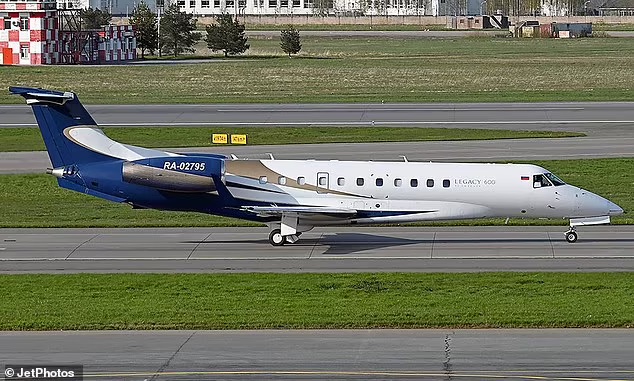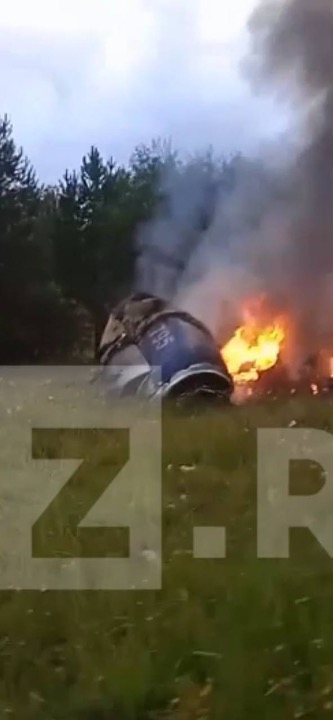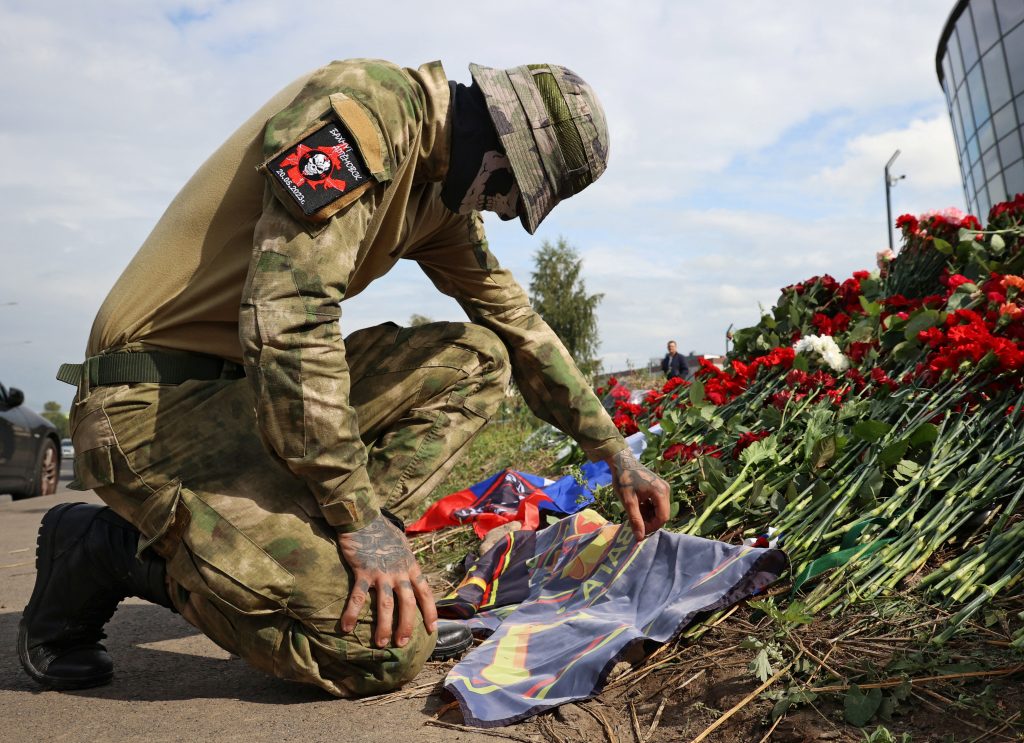This article was updated on August 24 at 2:21 p.m. to reflect unfolding events.
As Russia continues its assault on Ukraine, the Atlantic Council’s Digital Forensic Research Lab (DFRLab) is keeping a close eye on Russia’s movements across the military, cyber, and information domains. With more than seven years of experience monitoring the situation in Ukraine—as well as Russia’s use of propaganda and disinformation to undermine the United States, NATO, and the European Union—the DFRLab’s global team presents the latest installment of the Russian War Report.
Security
Prigozhin reportedly dies in plane crash
Tracking narratives
Russian media and Telegram channels debate Prigozhin’s status
Rumors swirl on the nature of the crash
Prigozhin reportedly dies in plane crash
On Wednesday, August 23, an Embraer ERJ-135 business jet with tail number RA-02795 crashed in the Tver region of Russia. The Russian Federal Air Transport Agency later announced that Wagner Group founder Yevgeny Prigozhin was among those killed in the crash.
The incident was first reported at approximately 7:20 pm local time on Telegram channel 112. About thirty minutes later, the Ministry of Emergency Situations of the Russian Federation (MChS) posted on its Telegram channel an official statement indicating that there were ten people on board, including three crew members. MChS stated that the incident occurred near the village of Kuzhenkino in Tver Oblast while the plane was flying from Moscow to St. Petersburg. According to flight tracking service FlightRadar24, the plane experienced a series of rapid descents and ascents thirty-six minutes after takeoff before losing its data signal.
Video footage of the plane’s descent and subsequent debris field appeared on multiple Telegram channels shortly after the incident. News outlet Izvestia published a video showing tail debris featuring the digits “795,” adding to rampant speculation at the time suggesting the crash had indeed involved RA-02795.


Soon after the crash, TASS and RIA Novosti reported that Yevgeny Prigozhin was among the passengers on the plane, based on a manifest filed with the Federal Air Transport Agency. These reports of Prigozhin’s presence on the plane came remarkably swiftly; as noted by the Vyorstka Telegram channel, it usually takes the agency a few hours to reveal such information. According to Vyorstka, reports of Prigozhin’s presence based on the manifest appeared just three minutes after the initial report of the jet crash from the Ministry of Emergency Situations. Not long afterward, the Wagner-affiliated Telegram channel VChK-OGPU reported that Wagner commander and co-founder Dmitry Utkin was also on board the crashed plane.
As rumors about the crash spread across Telegram, Wagner Group-affiliated Telegram channel Grey Zone published information about a second private aircraft, also allegedly owned by Prigozhin, that was seen “circling” over Moscow, generating speculation that Prigozhin could have been on board the second craft. According to the Readovka Telegram channel, Prigozhin often checked in as a passenger on one plane but would then board the other plane for security reasons. The aircraft in question eventually landed at Moscow’s Ostafyovo airport, without any additional information concerning Prigozhin.
Just before 11:00 pm local time, the Federal Air Transport Agency published a list of people it said had been flying on the Embraer that crashed in the Tver region, including Prigozhin and Utkin.
—Victoria Olari, research assistant, Moldova
Russian media and Telegram channels debate Prigozhin’s status
On Telegram, the BRIEF channel reported that Prighozhin’s body was identified a few hours after the crash, citing Tsargrad TV and an unnamed source. Just prior to midnight local time, Meduza cited an Interfax report that the remains had yet to be identified. A report from Al Jazeera suggested that Prigozhin’s smartphone had been found at the crash site; following that, RBC, Moscow Times, and other Telegram channels amplified the claim.
Russian media later reported that two black vans had collected human remains at the site and transported them to a local morgue for identification. The pro-Wagner channel VChK-OGPU initially noted that investigators could not find passenger documents, so a combination of visual and genetic identification would be required to identify the remains. By early afternoon on August 24, though, VChK-OGPU claimed that Prigozhin had been identified due to a pre-existing physical condition—a partial missing finger on his left hand—while Dmitri Utkin’s remains were matched with his tattoos. At the time of publishing, however, officials had not confirmed this report, as they continue to examine the remains. On August 24, Russian President Vladimir Putin, in a televised address, gave his condolences to the families of those killed in the crash and said Prigozhin was a “talented businessman,” suggesting that the Wagner Group leader was in fact killed.
In contrast, Tsargrad claimed that Prigozhin was alive in Mali, vaguely citing “African media.” Meanwhile, Russian regional media Prufy noted that Prigozhin had been reported dead on previous occasions. “Many journalists and political scientists believe that Prigozhin really could have simply disappeared,” it claimed without citing any sources.
—Roman Osadchuk, research associate
Rumors swirl on the nature of the crash
Russian Telegram channels also continue to speculate on what led to the crash. Initial claims suggested that the plane had been shot down by Russian air defenses. According to Wagner channel Grey Zone, “local residents heard two explosions typical of air defense systems before the plane’s crash, and this is supported by the contrail patterns in the sky in one of the videos, along with the testimony of direct witnesses.”
The Rybar Telegram channel voiced similar reports. Alongside a video of the crash, it wrote, “according to the [camera] operator, initially there were two explosions heard, indicating the work of air defense systems. Against the backdrop of constant flights of Ukrainian drones over Moscow, the possibility of a mistaken launch of an anti-aircraft missile system might be adopted as the primary theory.” Later, Rybar published photographs of fuselage parts documented by locals at the crash site. The channel also claimed there were no visible traces of missile damage. “Regarding a potential hit by S-300 or Buk missiles, the damage [visible] is clearly small,” the channel wrote.
Another hypothesis gaining increasing attention alleges an explosion from within the aircraft. According to the Mash and Baza Telegram channels, investigators are considering the possibility of a “terrorist attack.” The SHOT channel, citing anonymous sources, claimed that a “bomb device” was allegedly hidden within the plane’s undercarriage compartment. This would explain why the tail section of the plane fell five kilometers away from the fuselage, the channel added.
In an interview with Fontanka, aviation expert Vladimir Popov outlined three possible reasons for the crash. “My initial assumption is that something happened with the automated control system; perhaps the control system malfunctioned,” he said. “The second theoretical reason is a drop in speed triggered by engine stall. The third potential reason is an explosion.”
In an interview with the website Moscow Komsomolets, military expert Yuri Knutov appeared to rule out the theory involving Russian air defense systems. Instead, he speculated without providing evidence that Ukrainian intelligence agencies might be responsible for the plane’s destruction. “I don’t rule it out,” he said. “Considering the threats from Budanov, the head of Ukraine’s Main Intelligence Directorate (GUR), their attempts to sabotage the Crimean Bridge, the assassinations of Darya Dugina and Maxim Fomin, and the assassination attempt on Prilepin, all of this indicates that such an operation could have been planned and carried out by Ukrainian intelligence agencies.” Tsargrad TV circulated a similar theory, citing an unnamed aviation agency source who stated, “Prigozhin’s plane was blown up. And behind this is the Main Intelligence Directorate of the Ministry of Defense of Ukraine.”
Independent Russian outlet Meduza attempted to analyze footage of the incident. The article noted that video documented the plane descending erratically, its wings and tail section falling separately, with the audio suggesting that at least one engine remained operational. The author deduced that these observations indicate that the crash was preceded by an explosion.
Russian law enforcement continues to investigate the reasons for the crash, with one source telling RBC that the investigation is focusing on “external influence,” technical problems, and pilot error. Russian media have studiously avoided speculating that Putin, in an attempt to avenge Prigozhin’s attempted mutiny exactly two months prior to the crash, was behind the incident.
—Victoria Olari, research assistant, Moldova
